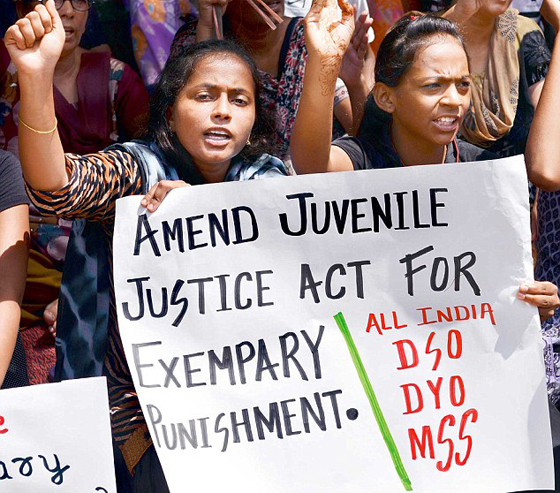Last week, the Minister for Women and Child Development introduced the Juvenile Justice Bill in the Lok Sabha (Press Trust of India, 2014). The main purpose of the Bill is to increase the scope for punishing juveniles aged 16 and above who commit serious crimes such as rape. The debate surrounding the need for such a law was sparked after the 2012 Nirbhaya gang rape case, where one of the six offenders was tried as a juvenile and received an arguably paltry sentence of three years in a reform home (TNN, 2014).
India increased its juvenile age from 16 to 18 in 2000, after signing the United Nations Convention on the Rights of the Child (Viswanathan, 2013). Last year, 43,506 cases were registered against juvenile offenders, of which 28,830 were committed by those between 16 to 18 years of age (Hindustan Times, 2014). The number of crimes committed by juveniles increased by 13% between 2012 and 2013, and the most increase was seen in crimes against women, out of which outrage of modesty saw the largest increment of 132% (CNN-IBN, 2014).


Globally, countries like the US and UK, who have also signed the UN Convention and have fixed the upper age of minors as 18, have provisions for minors to be tried as adults (Sugden & Rana, 2013). India, too, would benefit from following such a precedent as it would help the country attain a balance between adequate protection of child rights and justice for victims who suffer at the hands of juvenile offenders. Additionally, the re-setting of an age restriction will not help get rid of the problem that was faced in the 2012 case, as a perpetrator can still get away with a serious crime if he/she is even slightly short of the upper limit for minors.
Justice J.S. Verma, who led the Committee that made recommendations to revise the existing sexual assault laws in India post the 2012 case, was against the lowering of the juvenile age. He argued that children could not be held culpable for the crimes they commit, without the state enabling them by providing them with basic rights (Perappadan, 2013). Child rights activists have contended that the nature of the crime need not necessarily reflect the maturity of a juvenile and that the level of punishment should be in line with their capacity to reform (Malhotra, 2014).


While these sentiments are understandable, it is also the duty of the government and the judiciary to ensure that rational and fully culpable criminals are not allowed to take advantage of existing laws. There must be a pathway for the judiciary to establish exemptions in special cases, which should depend on the nature of the crime rather than the age of the perpetrator.
It must be acknowledged, however, that increasing punishments and introducing solely punitive measures will not be enough to change the prevalent situation. There needs to be active effort on the government’s part to work at both macro and micro levels to change existing norms and attitudes around gender in general and sexual abuse in specific. The Prime Minister, in his Republic Day speech, spoke rather eloquently about the poor standing of women and girls in Indian society. However, he cannot be oblivious to the fact his own Health Minister is opposed to sex education in Indian schools, saying it is more in line with Indian values to promote celibacy and yoga (Editorial Board, 2014). The incongruity between the two episodes is conspicuous – how can one change social attitudes without teaching the young and old alike about correct sexual practices and behaviour? In the absence of such direction, the youth turn naturally to other sources of information such as movies, popular music and porn, which can to put mildly, be highly misleading.
In the words of Dr. Ranjana Kumari, “While believing in reform and totally committed to child rights, I think it’s important to consider the nature of the crime, especially in case of rape and murder. In some of the recent cases we have seen, those below 18 have inflicted more severe and serious nature of injury to the victim. Therefore, considering the nature of the crime, the Juvenile Justice Board should be empowered to forward cases to the adult courts.” She added that, “The problem in reducing the age is that it will still create conflict, as a perpetrator can be 15 years and 11 months.”
Discuss this article on Facebook



